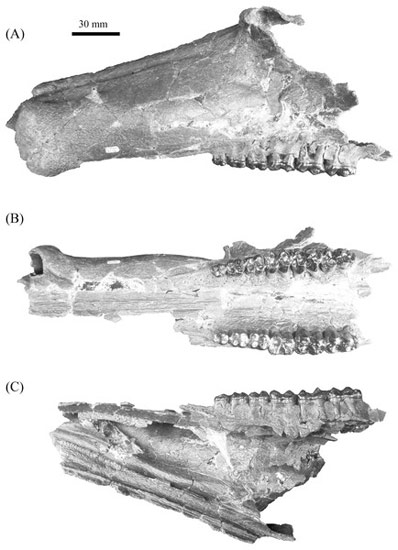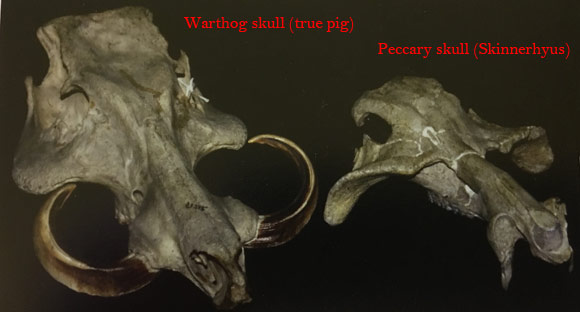Picking Up a Pair of Peccaries in Tennessee
Picking up a Peccary or Two
Scientists from East Tennessee State University in collaboration with colleagues from the University of Tennessee and the University of California have published a scientific paper on the discovery of two types of Pliocene peccary from the famous Gray Fossil Site located Washington County (north-eastern Tennessee).
Two Types of Pliocene Peccary
The town of Gray harbours a remarkable fossil quarry that has highly fossiliferous strata that dates from around 4.9 to 4.5 million years ago. The site represents a watery sink hole, that was once surrounded by an oak and hickory dominated forest. Since this location’s discovery nineteen years ago, a treasure trove of vertebrate and plant fossils has been excavated, permitting palaeontologists and palaeobotanists to build up a detailed picture of the ecosystem. Fossils of frogs, fish, salamanders and several reptiles including two types of alligator have been recorded, but perhaps the most spectacular fossils are the numerous specimens of mammals that have been discovered.
Views of part of the Skull of a Peccary from the Gray Fossil Site (assigned to Mylohyus elmorei)

Picture credit: PeerJ
Field teams have found evidence of short-faced bears, dwarf tapirs, sabre-toothed cats, prehistoric elephants (gomphotheres and Mastodons), camels, as well as rodents, bats and rabbits. Scientists can add another animal to the ecosystem – a peccary, to be precise, fossils of two different types of peccary have been found.
Prehistoric Peccaries
Peccaries may look like pigs but they are not true pigs (members of the Suidae family). Peccaries, or as they are sometimes known javelinas, are assigned to a different family (Tayassuidae). They probably share a common Eocene ancestor with the true pigs, however, by around 35 million years ago peccaries were established in North America and they have evolved independently away from European and Asian suoids.
Writing in the academic journal “PeerJ”, the researchers identify two different extinct species of peccary from skull and jaw fossils found at the site. The species are Mylohyus elmorei and Prosthennops serus. They are not new to science, after all the genera were erected in 1860 and 1877 respectively but neither of these extinct species has ever been found in this part of the United States before. P. serus has been found in fossil sites around the United States, but never before in the Appalachian region. With the confirmation that the Gray Fossil Site contains specimens of Mylohyus elmorei, the range of this species has been extended by over 500 miles northwards.
The Lower Jaw of the Extinct Peccary Prosthennops serus

Picture credit: East Tennessee State University
Commenting on the significance of the published paper, Dr Chris Widga (East Tennessee State University Museum of Natural History at the Gray Fossil Site), stated:
“Details of the peccaries’ teeth suggest that they spent their lives browsing on the leaves and fruits of succulent plants, so they would have been right at home in the Gray Fossil Site ecosystem, which we know from plant fossils was rich with tasty vegetation.”
How to Tell a Peccary from a Pig (True Pig)
Peccaries look superficially like pigs, they fill the same niche in the ecosystem (ground dwelling omnivores), but there are a number of striking anatomical differences. The canine tusks of peccaries are always very simple, either pointing up or down. In contrast the canine tusks of true pigs usually are more elaborate affairs, with distinct curves and often flaring out to the side. Peccary skulls tend to be much narrower and much shorter than pig skulls.
Comparing the Skull of a Pig (Warthog) to that of a Peccary
Picture credit: Christine Janis (Brown University) with additional annotation by Everything Dinosaur
The Gray Fossil Site
The Gray Fossil Site peccary material will help scientists to better understand subtle variations within each peccary species (intraspecific variation), which will aid peccary fossil interpretation and classification. In addition, the Gray Fossil Site material includes the most complete mandible found to date of Mylohyus elmorei.
Everything Dinosaur acknowledges the assistance of a press release from the East Tennessee State University in the preparation of this article.
The scientific paper: “First Occurrence of the Enigmatic Peccaries Mylohyus elmorei and Prosthennops serus from the Appalachians: Latest Hemphillian to Early Blancan of Gray Fossil Site, Tennessee” by Evan M. Doughty, Steven C. Wallace, Blaine W. Schubert and Lauren M. Lyon published in the journal PeerJ.
Visit the Everything Dinosaur website: Everything Dinosaur.


